Delaware • New Jersey • Pennsylvania
New York • United States of America
- Aquatic Life Designated Use Project
- Bacteria Monitoring
- Biomonitoring Program
- Chlorides Monitoring
- Contaminants of Emerging Concern
- Delaware Estuary Water Quality Monitoring Program
- Dissolved Oxygen and Nutrients
- Modeling
- Other Monitoring (e.g., Toxicity, Fish Tissue, Metals)
- PCBs and PMPs
- Special Protection Waters (SPW)
- Water Resource Data Sets
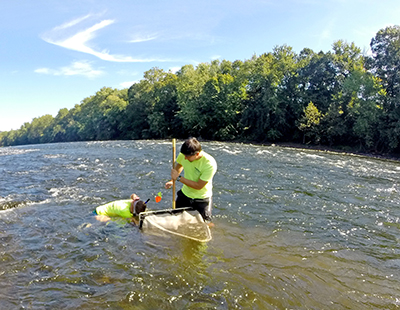 |
| DRBC staff perform biological monitoring of the Delaware River. Photo by DRBC. |
Program Background & Purpose
The DRBC's non-tidal Delaware River Biomonitoring Program surveys sediment, rocks, algae, aquatic insects and water chemistry at 25 sites throughout the non-tidal 200 miles of the Delaware River from Hancock, N.Y. to Trenton, N.J.
Data from this program provide a complete overview of the diversity and health of the aquatic life community and overall water quality of this stretch of river, which is protected by DRBC's Special Protection Waters (SPW) regulations.
Samples are collected every three to five years, typically during August and September, targeting the richest habitat areas of riffles, runs or island margins. Samples are analyzed by the Academy of Natural Sciences of Drexel University in Philadelphia, Pa.
Data assessed are included in the Delaware River Water Quality Assessment Report that DRBC develops every other year for the U.S. EPA.
• Next sampling event: 2024
Parameters Sampled
At each site, a variety of biological parameters are assessed:
• Diversity and health of the benthic (bottom-dwelling) aquatic life community, including macroinvertebrates (aquatic insects) and periphyton (algae);
• Habitat characteristics;
• Nutrients and Water chemistry (e.g., dissolved oxygen, temperature, pH and chlorophyll-a);
• Diversity and health of fisheries, aquatic plants and freshwater mussels; and
• Occurrence of invasive species, both aquatic and riparian plants and animals.
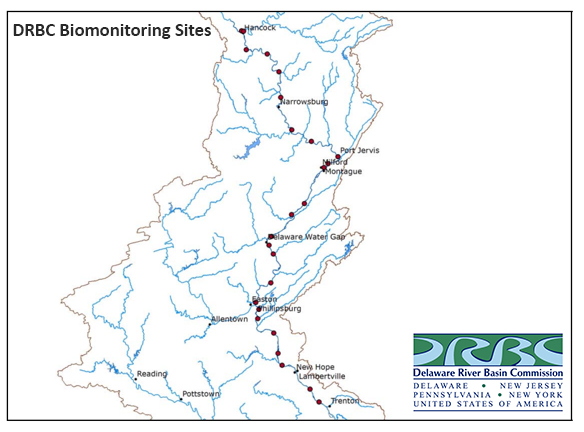 |
| Monitoring Site Locations for DRBC's Biomonitoring Program. Map by DRBC. View larger map (pdf) |
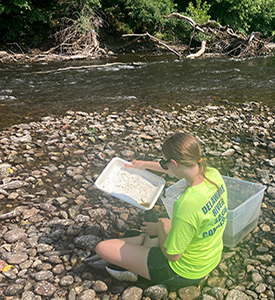 |
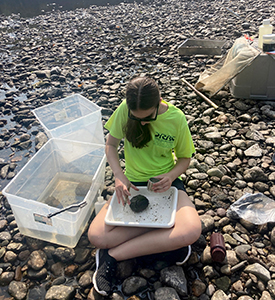 |
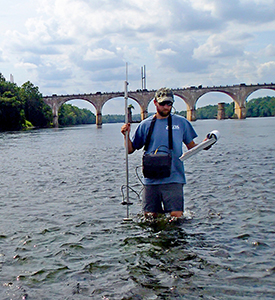 |
| Macroinvertebrates are collected from the Delaware River on a net and are then identified and counted by DRBC staff. Photo by DRBC. |
DRBC staff collect a periphyton sample as part of its biomonitoring program. Photo by DRBC. |
DRBC staff collects a flow sample from the Delaware River as part of its biomonitoring program. Photo by DRBC. |
 |
| DRBC staff examine a macroinvertebrate sample collected from the Delaware River. Photo by DRBC. |
Good Bugs Mean Healthy Rivers
Benthic macroinvertebrates are the main biological annual indicator assemblage monitored by DRBC and most other regulatory agencies.
As stated above, benthic means bottom-dwelling. Macro means you can see with the naked eye (no microscope needed). Invertebrates are creatures without backbones.
Examples of benthic macroinvertebrates include aquatic insects, worms, crayfish, clams and snails.
Analysis of macroinvertebrate communities to determine water quality is reliable and commonly used because:
• They are abundant in most streams and are relatively easy and inexpensive to sample;
• They are sensitive to environmental impacts;
• They are less mobile than fish, and thus cannot avoid discharges, spills, etc.;
• They are also able to detect non-chemical impacts to the habitat, such as siltation or thermal changes; and
• They bioaccumulate many contaminants, so that analysis of their tissues is a good monitor of toxic substances in the aquatic food chain.
Because of these reasons, studying macroinvertebrates helps provide an overall picture of water quality at a particular site.
Finding species that are sensitive to pollution is an indicator of good water quality.
The DRBC plans to develop and initiate a long term, basin-wide tributary macroinvertebrate monitoring program in order to monitor trends in macroinvertebrate community composition on a basin-wide scale.
Currently, the DRBC monitors the mainstem Delaware River and uses data collected by the basin states for the tributaries. These data are analyzed using varying methodologies, which can be difficult to compare, but a qualitative analysis shows that the population of macros in the Basin is currently considered in good shape.
Learn More
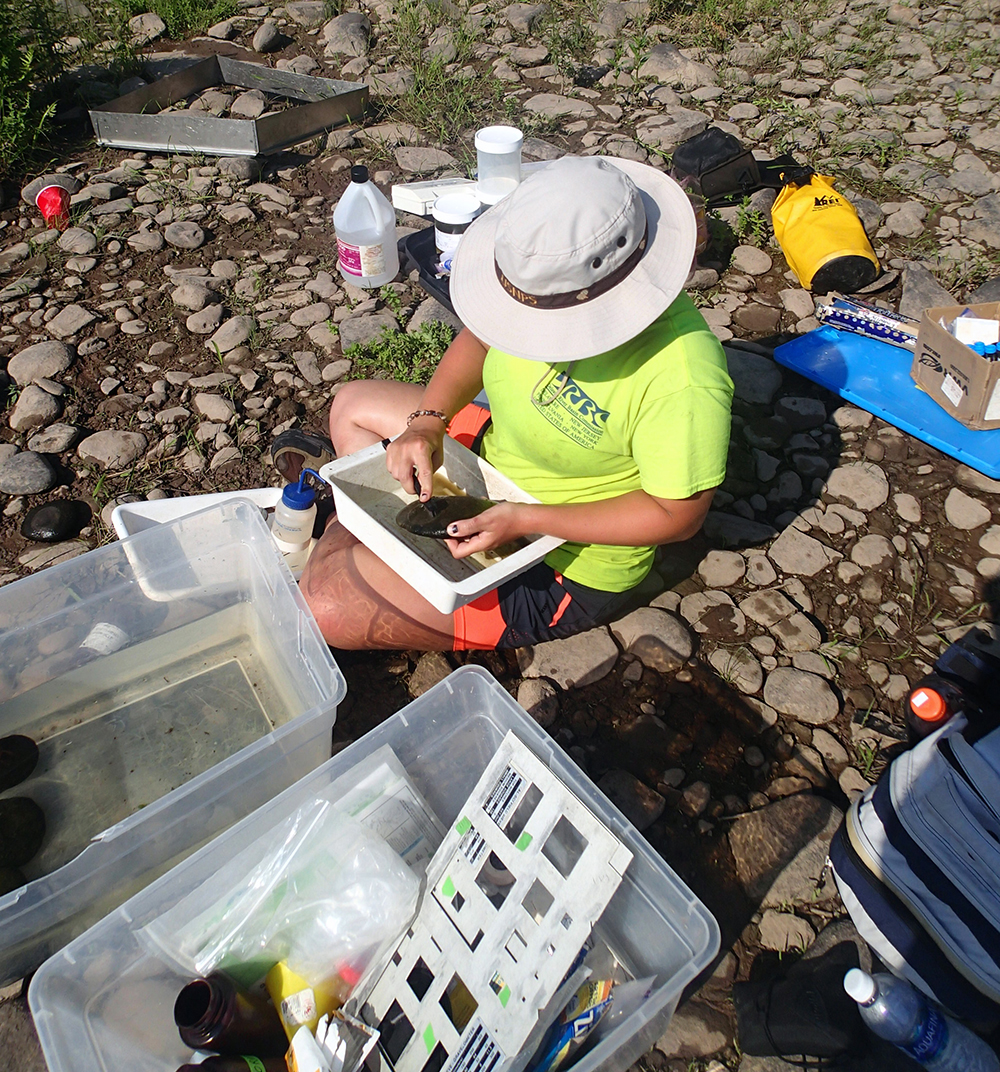 |
| DRBC staff collect a periphyton sample. Photo by DRBC. |
Algae that Tells a Story
Because the Delaware River is generally wide, shallow, clear and exposed to full sunlight, benthic periphyton are the river's dominant source of primary production.
Periphyton are sampled and monitored as an additional biological monitoring assemblage.
Examples of periphyton include diatoms and soft algae growing on rocks.
Periphyton are excellent indicators of short-term water quality changes, capable of providing biological signals for numerous pollution and habitat impacts; for example, eutrophication, salinity, ions, pH and sedimentation.
DRBC began surveying Delaware River benthic periphyton in a 2005 pilot study, launching full-scale periphyton monitoring in 2006.
Samples are co-located with the 25 benthic macroinvertebrate river survey sites and numerous special study sites on larger tributaries to the Delaware River.
Methods can be found in the 2014 QAPP, linked above.
These data will help assess general short-term Delaware River water quality and nutrient pollution impacts upon aquatic life.
Learn More
• Pilot Study: Implementation of a Periphyton Monitoring Network for the Non-Tidal Delaware River (pdf 1.7 MB; 2007)
• Nutrient Enrichment Study Data from the Upper, Middle, and Lower Sections of the Non-Tidal Delaware River – 2009 (link to USGS site for report)
State of the Basin 2019
- DRBC State of the Basin 2019 Report (see Pt. 4 - Living Resources)
Biomonitoring Program Specifics
- DRBC Delaware River Biomonitoring Program 2014 Quality Assurance Project Plan (2014 QAPP) (pdf 359 KB)
See the DRBC Biomonitoring Team in Action
Other DRBC Biological Studies
- Didymo, aka "Rock Snot," Discovered in the Non-Tidal Delaware River (2012)
- Lower Delaware River Mussel Survey (completed in 2013; see also freshwater mussels)
- DRBC Staff Helps with 2021 American Shad Young-of-Year Data Collection (see also American shad)
Invasive Species
Copyright © Delaware River Basin Commission,
P.O. Box 7360, West Trenton, NJ 08628-0360
Phone (609)883-9500; Fax (609)883-9522
Thanks to NJ for hosting the DRBC website